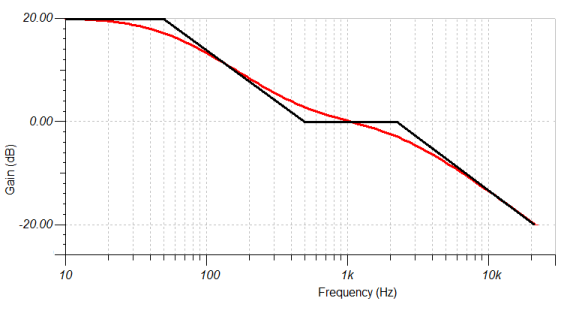
The RIAA replay equalisation response as measured in Stereo Lab

.png) The cutter head, which engraves the groove on a gramophone (phonograph) record is energised by a powerful audio amplifier - just like that used to drive a loudspeaker. Moreover, the disc-cutter itself is constructed very like a loudspeaker. The cutting stylus (rather than a cone of paper or plastic in a loudspeaker) is mechanically coupled to a coil through which the signal currents flow and the coil and stylus assembly are contrived to sit within field of a powerful magnet.
The cutter head, which engraves the groove on a gramophone (phonograph) record is energised by a powerful audio amplifier - just like that used to drive a loudspeaker. Moreover, the disc-cutter itself is constructed very like a loudspeaker. The cutting stylus (rather than a cone of paper or plastic in a loudspeaker) is mechanically coupled to a coil through which the signal currents flow and the coil and stylus assembly are contrived to sit within field of a powerful magnet.
Just as with a loudspeaker, in such an arrangement, it is the bass frequencies which cause the cutter to move the most: the high frequencies cause it to move only very slightly. (If you've ever looked at a loudspeaker cone as it reproduces music you'll recognise this.)
For this reason, the signal recorded onto a gramophone (phonograph) record is pre-equalised, whereby the bass is cut and the treble boosted during the cutting of the master disc. If this isn't done, the groove modulation due to the musical bass frequencies tends to throw the needle out of the groove on playback, or break through to an earlier rotation of the spiral groove in cutting; an effect called over-cutting. Additionally, by boosting the treble relative to the bass, a better overall signal to noise performance is secured. Replay electronics is therefore required to present a complimentary characteristic.

The RIAA replay equalisation response as measured in Stereo Lab
The electronic amplifier which corrects for the equalisation applied during recording is today universally called an RIAA preamplifier. The design of good, accurate RIAA equalisation has taxed the ingenuity of audio engineers for sixty years and, whilst very good hardware solutions exist, the best are very expensive.
Pspatial Audio believe that, after 60 years, hardware RIAA equalisation has just about reached the end of the developmental road and that equalisation is nowadays better performed in software for the following reasons:
Stereo Lab has internal processing in software which uses double-precision floating-point math. CD audio represents the audio signal with a dynamic range of 96dB, smaller then than the capacity of the human hearing system, which has a dynamic range of about 120dB. The very best analogue circuits can just about match this dynamic range. But, by contrast, double precision floating-point math is a binary format which has a precision of 53 bits or 320dB. That's a dynamic range which is ten billion (1010) times greater than the hearing system.
In providing digital equalisation as part of Stereo Lab, Pspatial Audio wished to offer a comprehensive range of these non-RIAA equalisation options for gramophone disc collectors whilst avoiding a complex and over technical user-interface. There's much more about this below and here. A video introduction is given below.
Clearly, this would be a serious criticism...... if it were true!
In fact, the spectrum of all music, irrespective of genre, falls with frequency. A generalised average for all types of music is taken to be a fall of approximately 3dB/octave. (Pink noise, with has an energy spectrum which falls at 3dB/octave, was invented as a test signal to emulate a typical music spectrum.)
Let's look at some measured data. The first trace illustrates the spectrum of about 6 minutes of classical music (Canteloube: Chants D'Auvergne, English Chamber Orchestra, Jeffrey Tate and Kiri Te Kanawa . Decca . 1995). Note how the high-frequency energy is very reduced, compared with the middle frequencies and bass. In fact, orchestral music typically doesn't contain much energy above about 4kHz.
Spectrum of excerpt from Canteloube: Chants D'Auvergne, English Chamber Orchestra, Jeffrey Tate and Kiri Te Kanawa. Note how the spectrum falls with frequency
But, that's classical music. How about other genres? Here is the spectrum of Loner by Black Sabbath (from the Black Sabbath 13 album). This is not only quite an aggressive sounding recording, it is also remarkable for its mastering technique such that the modulation is peak level throughout the entire track. Indeed, there is quite a lot of straightforward clipping evident. We might expect therefore that this record would have a more even signal spectrum than classical music. And indeed it does. But is still falls, as illustrated here.
Spectrum of the track Loner by Black Sabbath (from Black Sabbath 13 album . Vertigo 2013). Even this track demonstrates an obvious fall of energy with frequency
Both these tracks were equalised with the RIAA LP pre-emphasis curve and re-analysed. Notice how - even once this emphasis has been applied - the spectrum of the signal still falls with frequency in the case of the Canteloube.
Spectrum of excerpt from Canteloube: Chants D'Auvergne after RIAA pre-emphasis has been applied
And the Black Sabbath is transformed to have an almost perfectly flat response!
Spectrum of the track Loner by Black Sabbath after RIAA pre-emphasis has been applied
So, far from losing resolution by recording LP signals without RIAA correction applied, the technique improves resolution at HF without any sacrifice in the bass frequencies or midrange. The Black Sabbath example demonstrates that recording the unequalised groove signal actually maximises the available resolution from the digital medium!
In fact, we shouldn't be surprised by this. Disc equalisation was invented to maximise the resolution from an analogue medium. Engineers didn't refer to resolution in the analogue days: they referred to , dynamic range or signal-to-noise ratio but it was resolution all the same. Disc equalisation was designed to pre-equalise music signals so that they exploited the very limited resolution of the analogue disc medium. To do this, the equalisation curves chosen were mostly of the pole-zero-pole type in which two, dog-legged 6dB/octave portions were separated by a flat section. This emulated a 4dB/octave rise over the wide range of 10 octaves of the overall curve; a characteristic which was chosen roughly to compliment the falling 3dB/octave statistical energy-spectrum of music.
In providing digital equalisation as part of Stereo Lab, we wished to offer a useful range of these pre-RIAA equalisation options for gramophone disc collectors whilst avoiding a complex and over technical user-interface.
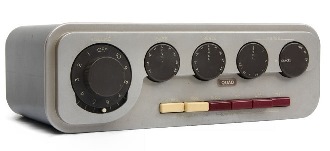
The Quad 22 Control unit whose simple controls inspired the EQ selections in Stereo Lab
Inspiration for how this might be achieved came in the shape of the Quad Electroacoustics 22 Control Unit, a hi-fi preamplifier which was introduced in 1959, close enough in time that many hi-fi fans possessed sizeable record collection with a variety of equalisation schemes applied.
Using clever circuitry, the Quad 22 featured three buttons which allowed the user to select common equalisation curves. In addition, they produced a scholarly list of labels and formats and the appropriate buttons to be selected when playing them. Stereo Lab has reproduced these curves and the Quad reference with due acknowledgement and reverence to this clever and practical solution to a very complicated problem.
The four equalisation options in QUAD 22 are given here.

So, Stereo Lab features 15 equalisation options which appear in the main process menu like this (RIAA and anti-RIAA are included in a separate menu).
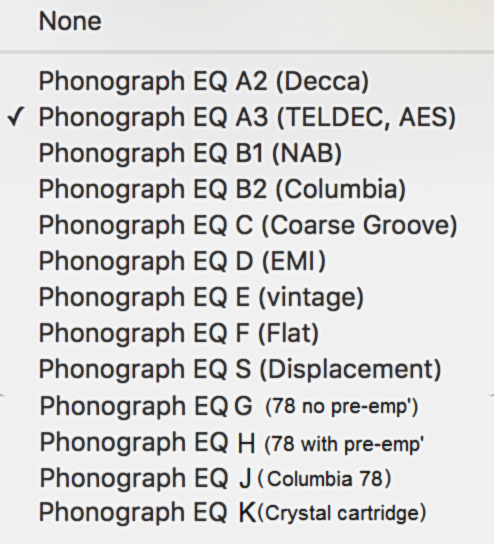
The QUAD Record Equalisation Guide is reproduced here. Pspatial Audio's Equalisation Guide is here. This brings the Quad table right up to date with the latest research.
Also go here for more information on recording characteristics and their history.
If you have various candidate equalisations for a particular recording, or a suspicion that RIAA may not have been used. It is easy to compare various equalisations. That is explained here.
Click here for a large version of this image.
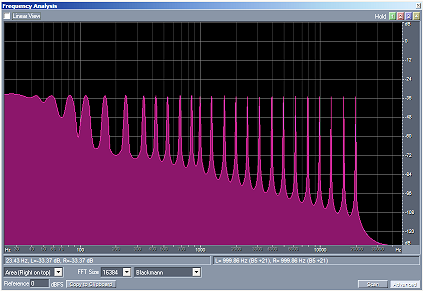
RIAA equalisation accuracy using Stereo Lab
The advantages of digital processing ensure that the equalisation is greatly more accurate than was possible in analogue hardware units. And, of course, being just a matter of mathematical calculation, the equalisation is always stable with time and temperature, and there are no components to age and go "off-value".
Causal filters
Importantly, the correction curves applied here are not derived from FFT curve fitting. Such a technique results in generating a non-causal, linear-phase filter which does not correctly compensate for the phase distortion introduced by the pre-emphasis filter. Unfortunately, this is the technique employed in most of the software solutions commercially available. Not only does this technique result in frequency response anomalies (we've measured around 1dB errors), but - much more seriously - it destroys the linear phase response of the pre-emphasis + de-emphasis chain.

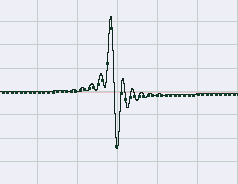
Instead, in Stereo Lab, the equalisation is performed in software with causal filters which are exact mathematical analogies of real analogue filters. The resulting overall phase-response being ±2° from 20Hz to 20kHz (RIAA, 96kHz sampling). See appendix for the details and a mathematical treatment of the filter implementation used in Stereo Lab.
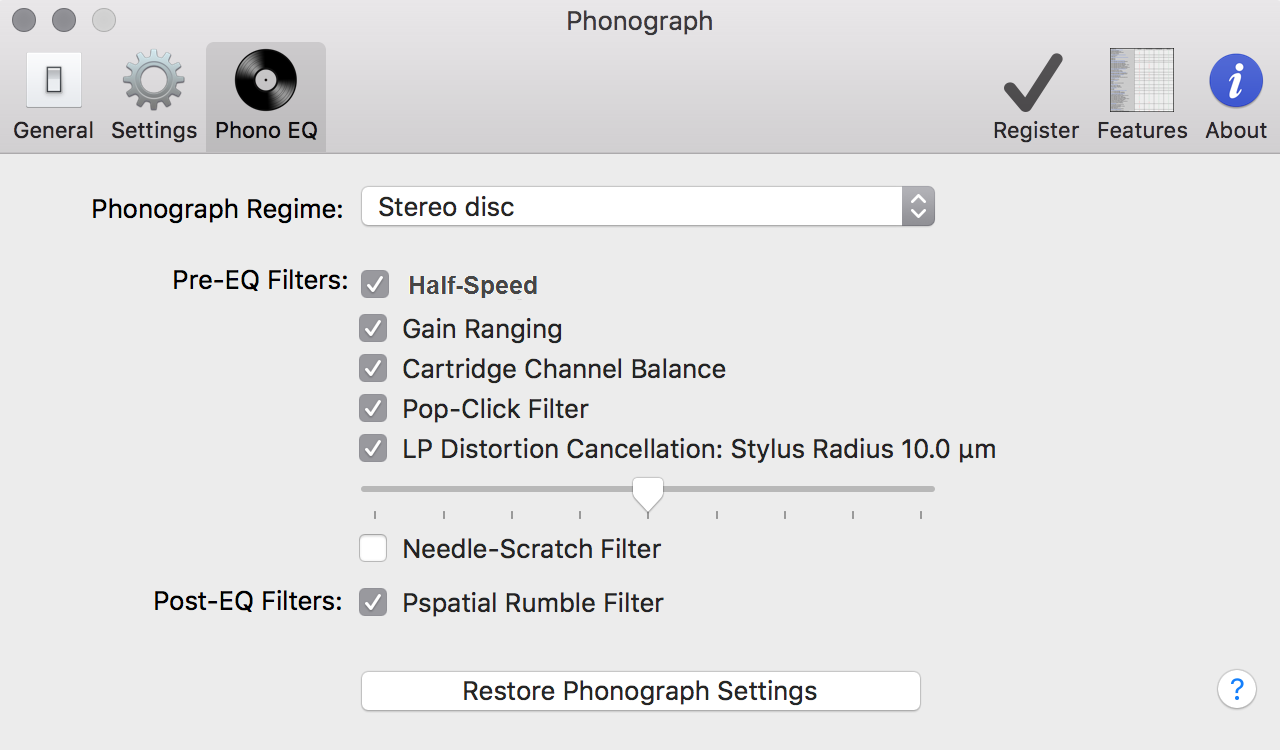
In a perfect world, all gramophone records would be perfectly flat. When they are not, they are said to be warped. (See more information on disc manufacture.)
Because records are an analogue medium, the cartridge transduces these very low-frequency modulations along with the audio. In addition, warps tend to provoke the inevitable resonance which exists with the combination of the arm-mass and the stylus mounting compliance which is at a very low-frequency and can produce large vertical modulations. Furthermore, the mechanical vibrations from the driving motor (both in the lathe and the reproducer) can be communicated to the turntable on which the record sits unless elaborate precautions are made. And the turntable bearing which must possess a very high degree of surface-finish if vibrations from aren't to be transduced by the pickup. The effect of these noise sources when they are present are combined into the term, rumble. A term which nicely describes their low-frequency character.
When warp or rumble are present they are better eliminated, surprisingly not always because of the unpleasant audible effects, for they are often sub-sonic, but because they reduce dynamic range and can cause damage to downstream equipment. The technique always employed to remove these effects is high-pass filtering and that is the approach taken in Stereo Lab too..... However, with a difference!
The Stereo Lab RIAA de-emphasis algorithm does not include the, so called IEC amendment with a further time constant at 7950µS for rumble and warp handling. Whilst this very gradual high-pass technique provides some protection against rumble and warp, it doesn't do a great job, and it also affects wanted frequencies in the lowest musical octave. The IEC amendment throws the musical baby out with the noisy bath-water! Instead a slightly under-damped fourth-order filter is employed with a turn-over at 20Hz such that the response is -3dB at 20Hz and falls away swiftly as frequency decreases. However, the response is maintained all the way down to 20Hz, so there is no effect upon the bass in the octave above the breakpoint. The graph below illustrates the response, and also compares the effect of the more normal IEC amendment time-constant.
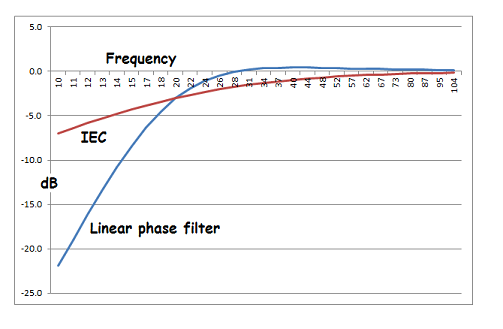
_small.png)
_small.png)
...... and this is the response of the acausal filer in Stereo Lab. Note how the time domain response is symmetrical; meaning that the output signal starts to respond before the input has arrived ......... esrevinu ruo ni elbissopmI !
The rumble filter is engaged by default (on all equalisation curves), but provision is made in the Phonograph EQ Preferences to de-select the warp and rumble when very good recordings are available. In which case correction is applied all the way to 0Hz.
The rumble filter is also made available as a stand-alone process in the main process menu.
Is the record Mono?
In the case of older, monophonic (mono) records the recorded information was encoded onto the disc by lateral (side to side) movements of the cutter, and is recovered by lateral movements of the stylus as it "reads" the groove. When stereo was introduced, the extra information was encoded as channel difference information in vertical movement of the cutter. The stereo phono cartridge thus responds to both lateral and vertical information and thereby recovers left and right channel signals.
When a stereo cartridge runs in the groove of a mono record, it is thus reading vertical information which is "not there". It simply responds to the natural roughness of the material, any dust and particles lying on the bottom of the groove and to any unwittingly encoded information or noise caused by vertical modulation in the cutting process. This last phenomenon is the biggest surprise when playing many mono recordings. Often there is substantial hum and rumble recorded in the difference signal which went unnoticed in its day for there was no way to hear it!
There is thus the absolute necessity to read the information on mono records as lateral stylus movements only which is achieved in Stereo Lab by selecting the Mono disc phonographic regime option in the Phonograph EQ Preferences
By ignoring vertical information (which we do when we select the "Mono disc" phonograph regime option in the Phonograph EQ Preferences), we ignore about 50% of the dust-induced "clicks and pops" as well as any unwittingly encoded vertical information. The effect on mono recordings of this process is often quite startling!
The technique of ignoring vertical modulation in mono recordings works for stereo recordings too, at the expense of channel separation. But the trade-off is certainly worth making sometimes - especially when a stereo record is noisy and damaged. To engage this mode, select the Damaged or noisy stereo disc phonograph regime option in the Phonograph EQ Preferences. In this mode, lateral information is weighted more strongly than vertical information.
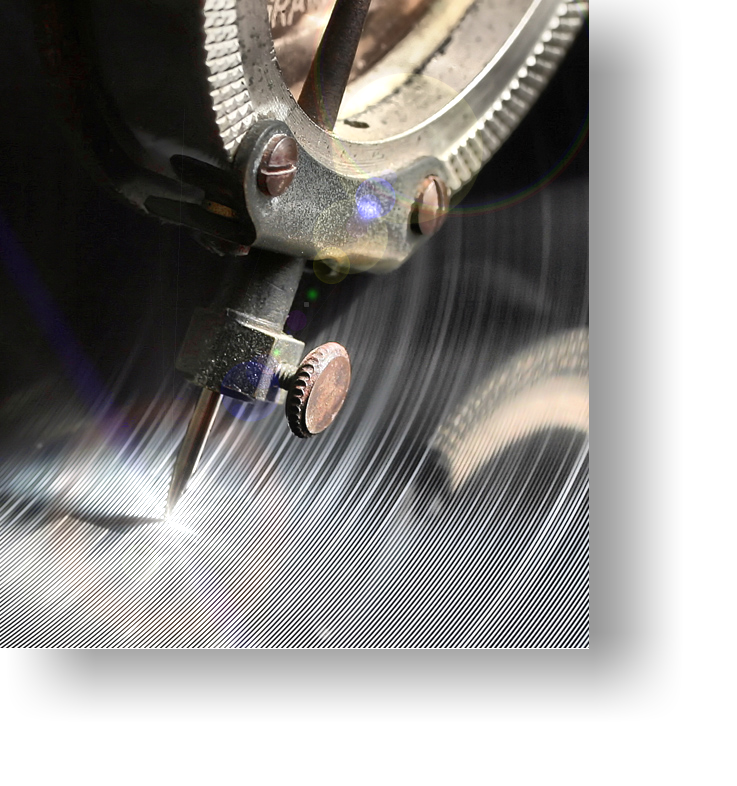 Seventy-eight RPM records were made of shellac with a ground slate filler which was added to the pure shellac to make it hard enough that records could support multiple playings with a tone-arm weight measured in ounces! But it is these particles of slate which contribute the harsh, surface-noise that we all associate with pre-vinyl records.
Seventy-eight RPM records were made of shellac with a ground slate filler which was added to the pure shellac to make it hard enough that records could support multiple playings with a tone-arm weight measured in ounces! But it is these particles of slate which contribute the harsh, surface-noise that we all associate with pre-vinyl records.
A unique needle-scratch removal process in Stereo Lab removes this annoying surface-noise. For more general information about needle-drops of 78 RPM records go here.
Stereo Lab includes statistical click detection and concealment techniques. Go here to read about our unique software to accomplish click detection and concealment without any interpolation or averaging techniques.
 To conclude: digitally recording your LP, 45 or 78 discs with no equalisation and applying equalisation and warp filtering with appropriately designed digital-filters has the following advantages:
To conclude: digitally recording your LP, 45 or 78 discs with no equalisation and applying equalisation and warp filtering with appropriately designed digital-filters has the following advantages:
H(jω) = [(1 + jω T1) (1 + jω T3)] / (1 + jω T2) ......... (A)
where T1 = 3180µS, T2 = 318µS and T3 = 75µS.
The complementary, replay characteristic is the inverse of the pre-equalisation transfer function given above. That's to say,
H(jω) = (1 + jω T2) / [(1 + jω T1) (1 + jω T3)] .......... (B)
Provided the time-constants are the same on the replay side, if we multiply this second equation by the first, all the terms cancel out leaving unity; meaning that the overall encode-decode process is transparent and the reproduced music will retain its original frequency and phase response.
Knowing that the combined effect of multiple filter networks has its mathematical equivalent in the multiplication of individual transfer functions, means we can infer that the correct, combined transfer-function may be synthesised from the combination of two, simple networks with the form,
H(jω) = 1/(1 + jωT)
And a third network of the form,
H(jω) = (1 + jωT).
This is how RIAA equalisation is realised in Stereo Lab. Exactly analogous with an analogue solution, but realised with the accuracy, repeatability and stability that digital signal processing offers. Other characteristic curves are generated in the same way their parameters being modified mutatis mutandis.
Note that Stereo Lab RIAA equalisation does not implement the "Neumann Pole" for reasons given here.
 Home page
Home page
For all support issues, go here.
For Pspatial Audio sales, email: sales@pspatialaudio.com
